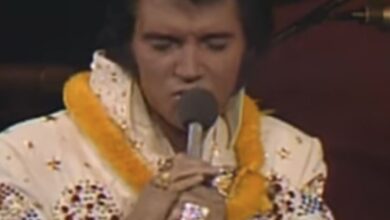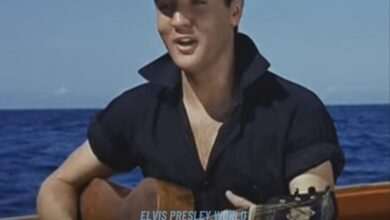Possibly His Finest Vocal Performance on Live TV, These Are Timeless Classics. Rest in Peace Elvis
Elvis Presley’s involvement in the entertainment world is a remarkable tale steeped in cultural significance, and his 1956 color screen test for “The Rainmaker” provides a glimpse into the early years of a legend. This performance not only showcased his extraordinary vocal ability and charismatic stage presence but also marked a turning point in the way rock and roll was perceived. It was during the mid-1950s that Elvis emerged as a formidable force, blending various musical influences that appealed to a diverse audience.
The setting of the screen test was emblematic of the era, characterized by a burgeoning interest in rock and roll music, fueled by the cultural shifts following World War II. Young people were seeking new forms of expression, and Elvis personified this change. His energetic rendition of “Blue Suede Shoes” encapsulated the spirit of youth, rebellion, and the exploration of personal identity. The iconic song, originally written and performed by Carl Perkins, resonated deeply with the sentiments of the time — emphasizing themes of pride and the desire for self-verification.
Elvis’s unique style incorporated elements from rhythm and blues, country music, and rockabilly. His interpretation of “Blue Suede Shoes” played a crucial role in popularizing the rockabilly sound, which was characterized by its twangy guitar riffs and energetic beats. This genre became synonymous with Elvis, whose ability to merge various musical styles not only changed the landscape of popular music but also influenced countless artists who followed. The marriage of his vocal prowess and dynamic performance style created an enduring legacy that transcended racial and generational boundaries.
In the screen test, viewers caught a glimpse of Elvis’s distinctive persona — a blend of charm, confidence, and a bit of mischief. His iconic hip-swiveling, often imitated but never replicated by others, conveyed a sensuality that captivated audiences. This aspect of his performance contributed to the controversy surrounding his image, drawing both adoration from fans and criticism from conservative factions of society that deemed his moves inappropriate. Elvis’s ability to evoke such strong reactions further solidified his status as a cultural icon, setting the stage for an era of musical revolution.
As the years passed, “Blue Suede Shoes” became more than just a hit; it evolved into a cultural artifact. The song’s catchy melody and relatable lyrics made it an anthem for youth. Elvis’s version was characterized by a rawness and authenticity that many admired, prompting a new generation to explore rock and roll. The melding of playful energy with a touch of rebelliousness resonated with the youth of the time, encouraging them to embrace music that reflected their desires and frustrations.
Elvis’s charisma was integral to the performance, but the music itself also played a vital role in his rise. “Blue Suede Shoes” featured a driving rhythm that called out for movement, urging listeners to dance and let loose. The song highlighted a critical evolution in the music industry as well, with the emergence of rock and roll as a dominant genre. Although many argue that the genre’s roots reached back to earlier American music forms, it was artists like Elvis who brought it to the forefront of popular culture, ensuring its place in music history.
This performance also foreshadowed Elvis’s ascent into the film industry. After his successful music career began to flourish, he ventured into acting with several films that showcased his musical talents. The screen test for “The Rainmaker” exemplified the crossover appeal that he would become known for: the ability to draw fans not just through music but also through his engaging presence on screen. His film career spanned several years, during which he starred in numerous musicals that further cemented his status as a multi-faceted entertainer.
Presley’s influence stretched well beyond music into fashion and lifestyle, inspiring fans to adopt his signature look of flashy clothing, slicked-back hair, and a confident demeanor. This transformation extended the impact of “Blue Suede Shoes” beyond its melodic and lyrical content, making Elvis a trendsetter for his generation. The song’s call to action — taking pride in one’s possessions — resonated with fans who sought to emulate the life of the star, further intertwining his personal narrative with the cultural zeitgeist of the 1950s.
As the decades progressed, Elvis’s music continued to evolve while maintaining its roots in rock and roll. His career saw numerous resurgences, and “Blue Suede Shoes” was often revisited, reinterpreted, and celebrated. Other artists across various genres have covered this classic, ensuring its relevancy in popular music. These renditions, from rock to jazz, reveal the song’s versatility and highlight Elvis’s original version’s lasting legacy.
Today, numerous documentaries, films, and retrospectives investigate Elvis’s impact on music and culture. His screen test for “The Rainmaker” remains a cherished artifact that captures the early exuberance of a young man destined for greatness. The world continues to recognize and celebrate the contributions of Elvis Presley to the music industry, ensuring that his legacy, symbolized by performances like the one for “Blue Suede Shoes,” will never be forgotten. His journey from a struggling artist to a global icon serves as a testament to the power of music and the enduring influence of a person who dared to innovate and break barriers.



